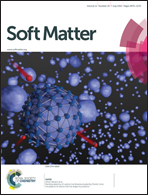Yield stress and elasticity influence on surface tension measurements
Abstract
We have performed surface tension measurements on carbopol gels of different concentrations and yield stresses. Our setup, based on the force exerted by a capillary bridge on two parallel plates, allows us to measure an apparent surface tension of the complex fluid and to investigate the influence of flow history. More precisely the apparent surface tension measured after stretching the bridge is always higher than after compressing it. The difference between the two values is due to the existence of a yield stress in the fluid. The experimental observations are successfully reproduced with a simple elasto-plastic model. The shape of successive stretching–compression cycles can be described by taking into account the yield stress and the elasticity of the gel. We show that the surface tension γLV of yield stress fluids is the mean of the apparent surface tension values only if the elastic modulus is high compared to the yield stress. This work highlights that measurements of thermodynamic quantities are challenged by the fluid out-of-equilibrium state implied by jamming, even at small scales where the shape of the bridge is driven by surface energy. Therefore setups allowing for deformation in opposite directions are relevant for surface tension measurements on yield stress fluids.


 Please wait while we load your content...
Please wait while we load your content...